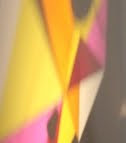abstronics...

"abstronics" is what lewis carrol would have called a portmanteou word. it is composed of the first one and a half syllables of "abstractions" and the last one and a half syllables of "electronics". the letter "r", fortuitously, is the hinge of the two parts"...this word, "abstronics", was suggested to me by albert tomkins and aptly connotes this important fact: today it is possible for invisible events in the sub-atomic world to be made to have esthetic manifestations which an artist can control, and, via motion pictures, organize into an interesting and meaningful visual experience...for years i have tried to find a method for controlling a source of light to produce images in rhythm. i wanted to manipulate light to produce visual compositions in time continuity much as a musician manipulates sound to produce music... on january 31, 1932, we (bute and leon theremin!) gave our first demonstration of "the perimeters of light and sound and their possible synchronization". this was an early use of electronics for drawings...dr. potter (of bell labs) designed an electronic circuit for such an application of the oscilloscope... by turning knobs and switches on a control board i can "draw" with a beam of light with as much freedom as with a brush... by careful conscious repeptition and experiment, i have accumulated a "repertoire" of forms. the creative possibilities are endless..."
images & excerpts from a 1954 article in "film in review" magazine written by mary ellen bute. if you've never seen her beautiful films you can see a pre-oscilloscope film here and some of her more sophisticated films are part of this dvd collection.
Labels: abstraction, experimental film, mary ellen bute, theremin


4 Comments:
I love those Mary Ellen Bute films- there was just a centenial retrospective screening of her work here in Chicago but I missed it- the films on Unseen Cinema are really beautiful (though I often find myself skipping to the insane Busby Berkeley clip that follows them).
yes, the unseen cinema is incredible for its breadth and also incredibly frustrating in its breadth as well. the busby berkely clips are interesting, but simply inserting them into the context of the other films to prove they are more than what they are is totally misguided (also, why are certain people's films are not grouped together on one disc). curatorial practice these days seems to be about inserting things into histories they were never a part of.
i saw a program of films the same curators put together before the dvds came out and they had all these really early medical films that were pretty disturbing. they were marginally interesting, but again, had nothing to do with the intentions of the avant garde and the rest of the filmmakers. it was just a way of inserting something into the program that would ruffle some feathers. almost half the audience left the theatre... not because they were artistic or avant garde but because they were horriffic... it was totally stupid, and in many ways devalued the films as well as the whole curatorial program... ugh... sorry for the rant....
Steve- I agree with about Unseen Cinema to a degree- There's a ton of stuff (particularly on the Amateur as Auteur and Picturing the Metropolis discs) that I not sure can be called Avant-Garde however loose your definition. As collector of vernacular photography I'm always coming across stuff that "looks" Avant-Garde- an oddly framed street shot that echoes Moholy-Nagy, a double exposure that looks just like a Man Ray photogram- but clearly has nothing to do with the Avant-Garde. The curatorial question you have to ask yourself is there anything to be gained by looking at them side by side? Sometimes the excitement of finding something really unusual makes you want to bend the rules to accomodate it which is usually a mistake. I saw the same program you did with the early 20th c. footage of mental patients having seizures etc... and, while I found the footage viscerally powerful, it completely threw the balance of the program off- it wasn't a challange or corrective to the accepted notion of what might be Avant-Garde, it was just "other". That said, I think the inclusion of Busby Berkeley in the Unseen Cinema collection does stretch (and challange) the notion of just what was/is Avant-Garde cinema in a good way though I'd agree that perhaps the sequencing could have been better
you hit the nail on the head here "The curatorial question you have to ask yourself is there anything to be gained by looking at them side by side?". in the case of the berkeley stuff i'm not sure - i think there is potential in the idea, probably not in the execution (i like it in the context of the film that has erik satie bouncing in slow motion...:-). in the case of the vernacular stuff probably more so because of the depth of them... maybe an extra disc of just musical numbers would've been even better! i felt the same way about the medical films. they were interesting, just not an hour of them at the end, which seemed simply there to see how many people would walk out. in terms of an artaud fest, maybe; but with the rest of the stuff it didn't make a hell of a lot of sense...
Post a Comment
<< Home